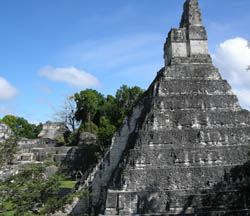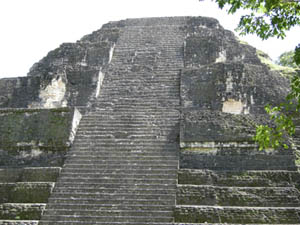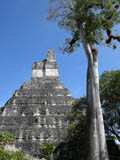In Lord Chocolate's Domain
Northern Guatemala and Belize
by Sarah Shuckburgh
Exploring subtropical
rainforest and exotic wildlife, Sarah Shuckburgh journeys to
the heart of Guatemala’s ancient Maya civilisation and finds
towering temples and riveting views.
 Howler monkeys woke me before dawn with their strange
grinding call, and from the ceiling of my lakeside casita,
yellow-bellied geckos added their noisy croaks. Howler monkeys woke me before dawn with their strange
grinding call, and from the ceiling of my lakeside casita,
yellow-bellied geckos added their noisy croaks.
As the sun rose, I drove with Pablo, my guide, deep into
the rainforest of Petén in northern Guatemala, heading for
the ancient city of Tikal. Once the capital of the Mayan
civilisation, with 4,000 buildings and 90,000 inhabitants,
Tikal was mysteriously abandoned in about 900AD and for more
than a thousand years was swallowed up by dense vegetation.
Locals knew about the ruins, but European explorers
discovered them only in the 19th century.
 Tikal is spectacular and awe-inspiring – a labyrinth of
limestone structures, half-hidden by subtropical jungle.
From a grassy central plaza one can wander alone through
palace courtyards and bedrooms, or scramble up the north
acropolis, with its jumble of temples, stumpy pillar-shaped
altars and carved stone stelae, some with hieroglyphs still
visible. Tikal’s earliest architecture dates from 500 BC but
the city’s Classic age began in 250AD. Successive religious
rulers, such as Great Jaguar Paw and Stormy Sky, each left
their mark with new or extended buildings. In the late 7th
century, the tall and long-lived Lord Chocolate and his son Caan Chac erected the grandest temples of all. Some of their
jade, ceramics, sculpture and jewellery has survived, and is
displayed in the museum, with a fascinating model of how
Tikal once looked. Tikal is spectacular and awe-inspiring – a labyrinth of
limestone structures, half-hidden by subtropical jungle.
From a grassy central plaza one can wander alone through
palace courtyards and bedrooms, or scramble up the north
acropolis, with its jumble of temples, stumpy pillar-shaped
altars and carved stone stelae, some with hieroglyphs still
visible. Tikal’s earliest architecture dates from 500 BC but
the city’s Classic age began in 250AD. Successive religious
rulers, such as Great Jaguar Paw and Stormy Sky, each left
their mark with new or extended buildings. In the late 7th
century, the tall and long-lived Lord Chocolate and his son Caan Chac erected the grandest temples of all. Some of their
jade, ceramics, sculpture and jewellery has survived, and is
displayed in the museum, with a fascinating model of how
Tikal once looked.
 A few buildings have been partially restored but nearly
all lie buried under mounds of earth and vegetation, and the
jungle inexorably encroaches on even recently cleared sites.
It would be easy to lose one’s bearings in the dense
undergrowth, and I believed Pablo’s tales of spotting jaguar
at Tikal, as well as ocelot and tapir. Concealed among the
trees are dozens of architectural complexes, built on raised
ground, and each with a plaza surrounded by temple, pyramid,
oratorium, dwellings and other buildings. The remains of raised stone causeways lead to other ruined cities, deep in
the jungle. As long-limbed spider monkeys swung through the
canopy above our heads, we passed the remains of a ball
court - Mayan nobles played with solid rubber balls which
astonished Spanish explorers - and further on, the ruins of
a steam bath like those still used by highland Maya today. A few buildings have been partially restored but nearly
all lie buried under mounds of earth and vegetation, and the
jungle inexorably encroaches on even recently cleared sites.
It would be easy to lose one’s bearings in the dense
undergrowth, and I believed Pablo’s tales of spotting jaguar
at Tikal, as well as ocelot and tapir. Concealed among the
trees are dozens of architectural complexes, built on raised
ground, and each with a plaza surrounded by temple, pyramid,
oratorium, dwellings and other buildings. The remains of raised stone causeways lead to other ruined cities, deep in
the jungle. As long-limbed spider monkeys swung through the
canopy above our heads, we passed the remains of a ball
court - Mayan nobles played with solid rubber balls which
astonished Spanish explorers - and further on, the ruins of
a steam bath like those still used by highland Maya today.
 Skirting crocodile-infested reservoirs which once
provided the city with drinking water, we followed signs to
El Mundo Perdido (the Lost World). Here stands the 100-foot
high Great Pyramid, Tikal’s oldest surviving structure,
built in about 200 BC. From its flat roof, astronomers and
mathematicians discovered solstices, calculated complex
calendars and mapped the stars. My visit coincided with a
lunar eclipse, and I thought of Stormy Sky’s sages in the
5th century, correctly predicting such occurrences from this
very building. Skirting crocodile-infested reservoirs which once
provided the city with drinking water, we followed signs to
El Mundo Perdido (the Lost World). Here stands the 100-foot
high Great Pyramid, Tikal’s oldest surviving structure,
built in about 200 BC. From its flat roof, astronomers and
mathematicians discovered solstices, calculated complex
calendars and mapped the stars. My visit coincided with a
lunar eclipse, and I thought of Stormy Sky’s sages in the
5th century, correctly predicting such occurrences from this
very building.
In the Classic period, sacred ceremonies were conducted
in small, brightly-painted prayer rooms on temple roofs,
close to heaven. I clambered to the top of Temple I, built
to honour Lord Chocolate, whose tomb lies beneath it.
Recently restored but still surrounded by tangled forest,
Temple V is higher and steeper, with a series of alarmingly
rickety, almost vertical ladders. The ascent looked
terrifying, and coming down looked worse - I was too scared
to attempt it. Half a mile on, the towering Temple IV has a
new sturdy stairway with handrails. At 230 feet, this is the
continent’s tallest pre-Columbian building, and from the
top, I gazed out at hundreds of miles of variegated green, a
bobbled, motley carpet pierced by pale te mple roof-combs. It
was hot and humid, and utterly silent apart from the squawks
of toucans and parrots from the forest below. From this
viewpoint, I found it hard to believe that in the last
thirty years, almost half of Petén’s primary forest has been
destroyed by logging or slash-and-burn farming, or that half
a million people now live in this formerly pristine area.
Attempts are being made to preserve remaining tracts of
lowland subtropical habitat as part of the Maya Biosphere
Reserve. mple roof-combs. It
was hot and humid, and utterly silent apart from the squawks
of toucans and parrots from the forest below. From this
viewpoint, I found it hard to believe that in the last
thirty years, almost half of Petén’s primary forest has been
destroyed by logging or slash-and-burn farming, or that half
a million people now live in this formerly pristine area.
Attempts are being made to preserve remaining tracts of
lowland subtropical habitat as part of the Maya Biosphere
Reserve.
By the mid-16th century, most Mayan kingdoms had been
defeated by the Spanish, but one Mayan tribe, living near
Tikal, at Lake Petén Itzá, held out for 150 years, and were
the last to be conquered, in 1697. I was staying on the
forested bank of this unspoilt lake, in a small hotel owned
by Francis Ford Coppola. As the heat subsided in the late
afternoon, I canoed gently out across the calm water of the
lake. Later, after a swim in the pool, I lay in a hammock,
watching bright blue Morpho butterflies hovering over my
glass of Coppola’s own Californian wine.
 Next day we drove east, along hot, dirt roads dotted with
dilapidated shacks built of rough planks, mud and palm
thatch – today’s Maya poor, Pablo commented, live in similar
houses to the poor in Lord Chocolate’s day. Pigs, turkeys,
chickens, dogs and children scuttled to the dusty verges as
we approached. Men, bent double, hacked at weeds with
machetes. Cows and horses grazed under palm trees on
degraded pasture. Women washed clothes on riverbanks.
Stallholders sat on plastic chairs under awnings, as food
cooked in clay ovens. Next day we drove east, along hot, dirt roads dotted with
dilapidated shacks built of rough planks, mud and palm
thatch – today’s Maya poor, Pablo commented, live in similar
houses to the poor in Lord Chocolate’s day. Pigs, turkeys,
chickens, dogs and children scuttled to the dusty verges as
we approached. Men, bent double, hacked at weeds with
machetes. Cows and horses grazed under palm trees on
degraded pasture. Women washed clothes on riverbanks.
Stallholders sat on plastic chairs under awnings, as food
cooked in clay ovens.
The Mayan empire stretched beyond modern borders, north
from Guatemala into Mexico’s Yucatan peninsula, south into
Honduras and El Salvador, and east into Belize. Today,
modern descendants of the Maya still make up half the
population of the Mundo Maya – and speak 30 different Mayan
languages. At the Mopan river, I waved goodbye to Pablo and
crossed into Belize where I was met by a new guide, José.
In the forest a few miles from the border lie the ruins
of Xunantunich, a Mayan ceremonial site dating from 200AD
which, like Tikal, was suddenly abandoned in the 9th
century. From the top of its tallest temple, El Castillo,
another mesmerising view of seemingly endless jungle opens
up.
 I stayed that night at Chaa Creek Forest Lodge, home of
the charismatic Mick and Lucy Fleming. On a whim, as hippy
travellers in 1977, the Flemings bought 140 acres from a man
in a Belize City bar. Undaunted by a two-hour canoe journey
to the nearest town, the young couple erected an
earth-floored shack, grew fruit and vegetables – and had two
babies. Other intrepid travellers soon heard about the
Flemings and came to stay, and from these humble beginnings
today’s rainforest lodge has developed, with 26 comfortable
thatched casitas, and – for budget travellers - a forest
camp with stilted cabins, camp fire and communal washrooms.
Guests can still canoe to St Ignacio, but now there is also
a road. I stayed that night at Chaa Creek Forest Lodge, home of
the charismatic Mick and Lucy Fleming. On a whim, as hippy
travellers in 1977, the Flemings bought 140 acres from a man
in a Belize City bar. Undaunted by a two-hour canoe journey
to the nearest town, the young couple erected an
earth-floored shack, grew fruit and vegetables – and had two
babies. Other intrepid travellers soon heard about the
Flemings and came to stay, and from these humble beginnings
today’s rainforest lodge has developed, with 26 comfortable
thatched casitas, and – for budget travellers - a forest
camp with stilted cabins, camp fire and communal washrooms.
Guests can still canoe to St Ignacio, but now there is also
a road.
On a hilltop above the Flemings’ twenty-five acre organic
vegetable garden, a series of mounds mark the site of
another small Mayan settlement, which archaeologists believe
was a middle-class meeting place for competitive feasting
and displays of wealth. The wooded hilltop has dozens of
holes, dug as cool larders for food and drink – and for
burying corpses. The overgrown site is a peaceful, shady
lookout over endless acres of forest.
Hot after my walk, I followed a narrow path to the river,
and swam in the dark, opaque water between banks of tangled
forest. My body was gently nibbled by tiny fish. As I swam
upstream, an otter paddled across and disappeared into a
hole in the bank. From the forest came the weird call of
howler monkeys. At dinner under a lofty roof of bay-leaf
thatch, I heard accounts from excited guests of their day
spent canoeing, wading and scrambling through jungle caves
containing ancient Maya artefacts. One family had seen a
7-foot boa constrictor.
 Rainforest animals are famously hard to spot, but on my
way to the international airport next day, I stopped at the
wonderful Belize Zoo, where native animals live in forested
enclosures, dotted with Mayan statues. Suddenly I stood
within inches of sleek jaguars, spotted ocelots and shy
tapirs like the ones Pablo saw at Tikal. I studied the
garish plumage of the toucans and parrots that I’d heard
from the roof of Temple IV. Here were the crocodiles that
lurked unseen in reservoirs, and otters like the one I’d
glimpsed at Chaa Creek, and also margays, harpy eagles,
coatis, anteaters, spider monkeys, iguanas, ugly jaguarundis
- and boa constrictors even longer than seven feet. And
above the rainforest cacophony, the familiar whirring roar
of howler monkeys. Rainforest animals are famously hard to spot, but on my
way to the international airport next day, I stopped at the
wonderful Belize Zoo, where native animals live in forested
enclosures, dotted with Mayan statues. Suddenly I stood
within inches of sleek jaguars, spotted ocelots and shy
tapirs like the ones Pablo saw at Tikal. I studied the
garish plumage of the toucans and parrots that I’d heard
from the roof of Temple IV. Here were the crocodiles that
lurked unseen in reservoirs, and otters like the one I’d
glimpsed at Chaa Creek, and also margays, harpy eagles,
coatis, anteaters, spider monkeys, iguanas, ugly jaguarundis
- and boa constrictors even longer than seven feet. And
above the rainforest cacophony, the familiar whirring roar
of howler monkeys.
Sarah travelled with The Ultimate Travel Company
www.theultimatetravelcompany.co.uk
First published by
the Telegraph
©SarahShuckburgh
|